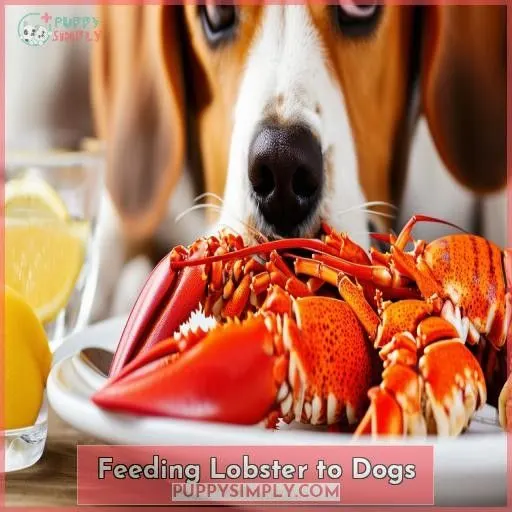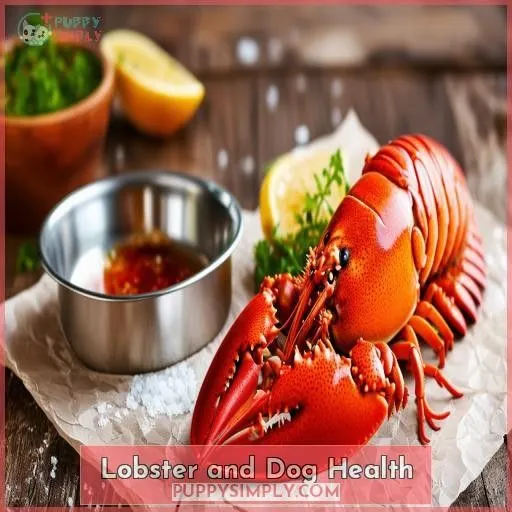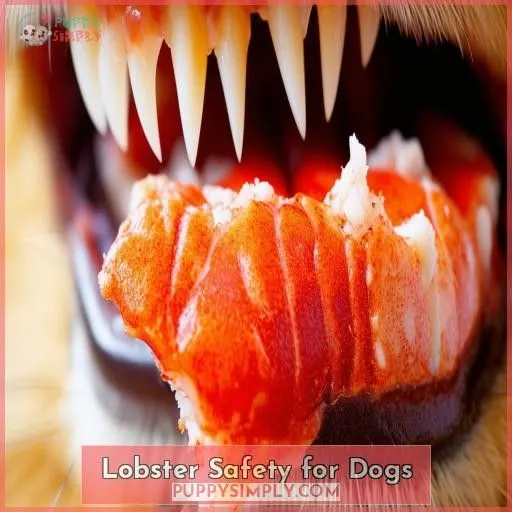This site is supported by our readers. We may earn a commission, at no cost to you, if you purchase through links.
 You can definitely feed your pup lobster meat as an occasional treat, but proper preparation is key.
You can definitely feed your pup lobster meat as an occasional treat, but proper preparation is key.
Lobster is packed with high-quality protein and healthy fats, but can harbor bacteria or cause allergic reactions if not cooked thoroughly.
Always remove the shell and inedible parts, boil or bake the meat, and let it cool completely before serving small portions.
Monitor your dog closely for any adverse reactions.
While lobster meat offers nutritional benefits, moderation is essential to prevent issues like pancreatitis or mercury toxicity.
With the right precautions, you’ll discover if this seafood delicacy gets two paws up from your furry friend.
Table Of Contents
Key Takeaways
- Lobster meat can be an occasional tasty treat for your furry friend, but moderation is key – a few bites for small pups, a tablespoon or two for medium-sized dogs, and several tablespoons for larger breeds.
- Proper preparation is crucial – remove all shells (a major choking hazard), boil or bake the meat thoroughly, let it cool completely, and portion out small servings to avoid digestive woes like pancreatitis.
- Keep an eye out for adverse reactions like vomiting, diarrhea, or skin irritation, which could indicate an allergy or sensitivity. Your pup’s safety comes first, so consult your vet beforehand, especially if your furry friend has any existing health concerns.
- While lobster meat offers some nutritional benefits like high-quality protein and healthy fats, too much can also bring potential risks like bacterial contamination, parasites, or even mercury exposure. So indulge your pup’s seafood cravings, but in moderation – a little lobster treat can go a long way toward keeping tails wagging happily.
Can Dogs Eat Lobster Meat?
Yes, dogs can eat lobster meat in moderation. Lobster meat is high in protein and low in fat, but it should be cooked thoroughly and given in small portions to avoid potential health issues like allergies, pancreatitis, or mercury toxicity.
Lobster Meat for Dogs
You’ll find that lobster meat can offer nutritional benefits for dogs, like being a good source of protein.
However, it also carries potential risks you should be aware of, such as its high sodium and cholesterol content.
Proper preparation is key to safely feeding lobster meat to your canine companion.
You’ll want to cook it thoroughly and avoid raw or undercooked seafood.
Nutritional Value
Lobster meat is a protein-packed treat for dogs. It provides:
- High-quality protein
- Essential amino acids
- Healthy fats
However, it’s also high in sodium and cholesterol, so moderation is key. With proper preparation, lobster meat can be an occasional, nutrient-dense indulgence for your furry friend.
Potential Risks
Feeding lobster to dogs comes with potential risks. You should be aware of 1) bacteria and parasites if not cooked properly, 2) allergies causing vomiting, diarrhea, and skin irritation, and 3) mercury toxicity in large quantities. Discuss with your vet, especially if your pup has pancreatitis, before offering lobster treats.
Preparation
You’ll want to cook lobster completely before feeding it to your pup. Cut it into bite-sized pieces to avoid choking risks. Keep these tips in mind:
- Remove all shells and inedible parts.
- Boil or bake the meat thoroughly.
- Let it cool completely before serving.
- Portion out small amounts as an occasional treat.
Proper preparation guarantees your dog can enjoy lobster safely and without digestive issues.
Lobster Shells for Dogs
Lobster shells pose a significant choking hazard for dogs, so it’s imperative to remove them entirely before feeding any lobster meat. These hard, indigestible shells can also irritate your dog’s digestive system if ingested, potentially leading to an obstructed bowel that requires immediate veterinary attention.
Choking Hazard
Lobster shells pose a serious choking hazard for dogs due to their:
- Size – difficult to swallow whole
- Shape – rigid with sharp edges
- Texture and hardness – virtually indigestible
It’s essential to remove all lobster shell pieces before feeding the meat to your furry friend. A single missed shard could cause a blockage or laceration, requiring immediate veterinary attention.
Digestive Issues
You’ll want to avoid feeding your pup lobster shells, as they can:
- Cause digestive upset like vomiting or diarrhea
- Trigger inflammation in sensitive or allergic dogs
- Potentially lead to pancreatitis if your dog overeats
Shellfish components aren’t easily digested, so it’s best to steer clear and opt for safer, dog-friendly treats instead.
Veterinary Attention
If your dog ingests lobster shells, seek immediate veterinary attention. Signs of an issue include:
- Lethargy or weakness
- Vomiting or diarrhea
- Loss of appetite
- Abdominal pain or bloating
- Obstructed bowel movement
Prompt veterinary care can prevent serious complications like intestinal blockages or punctures.
Feeding Lobster to Dogs
When feeding lobster to your dog, it’s vital to monitor portion sizes and keep an eye out for any adverse reactions. Offer only small amounts as an occasional treat, and consult your veterinarian for guidance on appropriate serving sizes based on your dog’s size, age, and health condition.
Portion Control
While lobster can make an occasional tasty treat, it’s important to limit portions. Keep servings to:
- A few bites for small dogs
- A tablespoon or two for medium-sized pups
- Several tablespoons for larger breeds
Too much rich lobster can lead to stomach upsets or pancreatitis flare-ups in sensitive dogs. Moderation is key to letting your pup enjoy seafood safely.
Monitoring
After establishing proper portions, it’s imperative to monitor your dog closely after feeding lobster meat. First, observe for signs of sensitivity or allergic reactions, like vomiting or skin irritation. Second, watch for digestive upset, such as diarrhea or stomach discomfort. Third, be prepared to manage any adverse reactions by contacting your vet immediately.
Lobster and Dog Health
You’ll need to be mindful of potential allergies when feeding your dog lobster meat. Some dogs may experience vomiting, diarrhea, or skin irritation after consuming lobster, so it’s wise to consult your veterinarian before introducing this seafood treat, especially if your pup has pancreatitis or other health concerns related to high-fat foods.
Allergies
Lobster can trigger allergic reactions in some dogs. You’ll want to watch for these potential 4 allergy symptoms:
- Vomiting
- Diarrhea
- Skin irritation
- Difficulty breathing
If your pup exhibits any of these signs after eating lobster, discontinue feeding it and consult your veterinarian immediately. Gastrointestinal distress and skin problems could indicate an adverse immune response.
Pancreatitis
Speaking of allergies, you’ll also want to be cautious if your dog has pancreatitis. Lobster can aggravate this condition, so it’s wise to:
- Consult your vet before feeding lobster
- Observe for symptoms like vomiting, diarrhea, and lethargy
- Avoid lobster entirely if your dog’s pancreatitis is severe
With pancreatitis, it’s better to err on the side of caution with regard to rich, fatty foods like lobster.
Mercury Toxicity
Another concern with feeding lobster is mercury exposure. Seafood can contain trace amounts of mercury, which can be toxic in large quantities. 1) Limit lobster treats 2) Cook thoroughly 3) Speak with your vet about safe portion sizes. While lobster offers some health benefits, moderation is key to avoid potential issues like food poisoning.
Lobster Safety for Dogs
When it relates to lobster safety for dogs, proper cooking is essential. You must guarantee that any lobster meat you intend to feed your pup is thoroughly cooked to eliminate potential bacterial or parasitic threats, and prevent spoilage that could lead to food poisoning.
Proper Cooking
You must cook lobster meat thoroughly to kill any harmful bacteria or parasites. Improperly cooked lobster can cause issues like:
- Food poisoning
- Sodium/cholesterol spike
- Allergic reaction
Dogs’ systems aren’t built to handle the potential contaminants in raw or undercooked lobster. Take the extra step – your pup’s health is worth it!
Spoilage Prevention
After cooking lobster for your pup, you’ll want to prevent spoilage. To extend its shelf life, consider:
- Refrigerating cooked lobster within 2 hours
- Freezing for longer-term storage
- Vacuum sealing to remove air exposure
Proper storage prevents bacterial growth, ensuring your furry friend enjoys a safe, tasty treat.
Raw or Undercooked Lobster
Building on proper storage, you should never feed your pup raw or undercooked lobster. Doing so risks:
- Bacterial contamination leading to digestive upset
- Parasite infection causing vomiting and diarrhea
- Mercury exposure from seafood posing health hazards
Thoroughly cooking lobster eliminates these dangers, but still, moderation is key for your furry friend’s wellbeing. Their safety comes first, always.
Frequently Asked Questions (FAQs)
Is lobster a healthy treat for dogs?
While lobster titillates your dog’s taste buds, it’s best savored sparingly. This delicacy packs a sodium and cholesterol punch, potentially causing digestive woes if overdone. Moderation is key for a pawsitively healthy treat.
Can dogs be allergic to lobster?
Yes, dogs can be allergic to lobster. It may trigger vomiting, diarrhea, and skin irritation in some pups. Always monitor your furry friend closely after introducing any new food, and consult your vet if you notice adverse reactions.
How much lobster is safe for dogs?
Moderation is key when feeding lobster to dogs. Give no more than a few bites as an occasional treat. Too much can cause health issues due to its high sodium, cholesterol, and potential contaminants. Always cook it thoroughly before serving.
Can lobster cause digestive issues in dogs?
Lobster, like many seafoods, can indeed cause digestive troubles for our canine companions. From vomiting and diarrhea to potential allergic reactions, it’s wise to introduce this delicacy slowly and in moderation.
Are there any risks of feeding dogs lobster?
Yes, there are risks when feeding dogs lobster. It can cause digestive issues, allergic reactions, and potentially contain harmful bacteria or mercury if not cooked and stored properly. Moderation is key for this high-sodium treat.
Conclusion
While letting your dog chew the fat with a lobster treat is fine in moderation, proper handling of this seafood delicacy is imperative.
Can dogs eat lobster meat? Yes, but take precautions – cook thoroughly, portion control, and monitor for adverse reactions like allergies or pancreatitis.
With diligent preparation and feeding practices, you’ll discover if lobster earns a stamp of approval from your canine companion.











